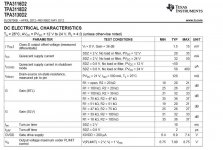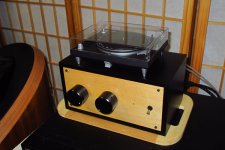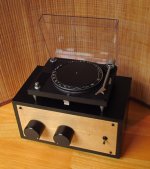Please let us know how that turns out.
Turned out great. Results are much the same to the 3100D2 Eval board with which I did a lot of gain comparisons. 36db sounds cleaner to me, wider, vocals more real - just something about the presentation I prefer.
BTW hooked up a 12v SLA earlier today, waaaay better than the meanwell I was using.
I'd say I'm about done with tinkering (for now). Happy with what I hear.
Last edited:
Also just noticed that the gain for the ebay 2.0 board is 26db. For some reason I thought it was 36 max gain. No wonder the 10uf was too much. I'll probably increase the gain as I preferred it when I had the 3100D2 board.
Just curious, how can one change the gain of the board?
Regards,
Just curious, how can one change the gain of the board?
Regards,
It's included in the datasheet as shown here....
I will try it with the next 3116 I'm putting together for a friend.
Attachments
You should really think about selling. That is really cool. Again, that is serious hipster bait gear.
Speaking of hipster bait audio. That amp would go great with something like this.
Love the Cardas posts. They are the best.
Your post about the similarities with the Orbit turntable gave me an idea. I've had this little novelty radio for 10+ years and if everything goes as planned it will eventually be able to serve 24/96 WAV files via an SD Card slot on the back. I like the idea a lot so I think that I'm gradually becoming a hipster too.
Attachments
It's included in the datasheet as shown here....
I will try it with the next 3116 I'm putting together for a friend.
KJA,
Thanks! So the board is in BTL (that's my guess) or SLV mode?
Regards,
KJA,
Thanks! So the board is in BTL (that's my guess) or SLV mode?
Regards,
BTL/Master
Before the YJ boards came out I ordered some 3118 and 3116 as I wanted to try this IC, my idea was to design my on pcb of 50mm x 50mm so I could order them from itead. Im a total newbie in electronics and this is my first audio amplifier pcb layout design, using the typical schematic from the datasheet using the components from the EVM, so please be kind with my design, I will soon order the pcb, once I try them, I will post the results and also the eagle files and gerbers in case any one else is intereseted in modifying the board or order some pcb.
An externally hosted image should be here but it was not working when we last tested it.
Last edited:
Hello diyaudio members!
I read the forums for a while, but this actual thread was the reason for me to finally join you.
At first i'd like to make an excuse for my lousy english.
I'm from germany and guess what, my first language is german.
After 4 weeks of waiting today my TPA3116 board arrived from china.
I built two 122cm high and 50cm deep hornspeakers in the meantime, which are driven by 8" fullrange speakers.
The TPA3116 is more than enough for this setup.
I connected two 6V accus and i can confirm that it works very well with 12V.
The sound is amazing for such a small and inexpensive device.
My next plan is to build a hornsub, which should be powered with the same board in btl-mode.
Did somebody successfully bridge the board (the red 2.0 yuanjing)?
Are there any boards with the TPA3106 chip available?
I read the forums for a while, but this actual thread was the reason for me to finally join you.
At first i'd like to make an excuse for my lousy english.
I'm from germany and guess what, my first language is german.
After 4 weeks of waiting today my TPA3116 board arrived from china.
I built two 122cm high and 50cm deep hornspeakers in the meantime, which are driven by 8" fullrange speakers.
The TPA3116 is more than enough for this setup.
I connected two 6V accus and i can confirm that it works very well with 12V.
The sound is amazing for such a small and inexpensive device.
My next plan is to build a hornsub, which should be powered with the same board in btl-mode.
Did somebody successfully bridge the board (the red 2.0 yuanjing)?
Are there any boards with the TPA3106 chip available?
Really love the amp KJA 2013. So simple and clean! What channel-switcher are you using? Something like this? Channel Band Rotary Switch 2P5T 12 Pin for Audio Device | eBay
Really love the amp KJA 2013. So simple and clean! What channel-switcher are you using? Something like this? Channel Band Rotary Switch 2P5T 12 Pin for Audio Device | eBay
Thanks Big SturL. I've had three different selector switches in this box, including an Alpha that looks similar to the one you linked, but ultimately installed a Greyhill series 71 switch which sounds quite good.
.
Hello diyaudio members!
I read the forums for a while, but this actual thread was the reason for me to finally join you.
At first i'd like to make an excuse for my lousy english.
I'm from germany and guess what, my first language is german.
After 4 weeks of waiting today my TPA3116 board arrived from china.
I built two 122cm high and 50cm deep hornspeakers in the meantime, which are driven by 8" fullrange speakers.
The TPA3116 is more than enough for this setup.
I connected two 6V accus and i can confirm that it works very well with 12V.
The sound is amazing for such a small and inexpensive device.
My next plan is to build a hornsub, which should be powered with the same board in btl-mode.
Did somebody successfully bridge the board (the red 2.0 yuanjing)?
Are there any boards with the TPA3106 chip available?
Buehgemeiste,
Welcome to diy!
Pics of the 1.26 meter tall horn speakers please. 🙂
Thanks for pointing out the TPA3106 40 watt chip. Seeing that the TPA3116 is 50 watts or 100 watts in BTL, not sure if there is a need for a 40 watt mono (which is probably the predecessor to the 3116 as it is dated 2010 and the 3116 is dated 2012).
The 3116 is really plenty of power for most folks with full range speakers or using high efficiency pro-audio style drivers. I never use mine at more than 60% volume - too loud.
The sub woofer forum has plenty of designs for efficient tapped horn subs that reach 40 Hz at 110 dB at 1 watt. Have fun!
Regards,
X
Pics of the 1.26 meter tall horn speakers please. 🙂
they do not look good yet.
they are made of chipboard and have no finish on the surfaces.
the pair did cost me only 80€ so far.
soundwise the result is perfect for that price.
but i have to keep it cheap with the finish somehow.
Thanks for pointing out the TPA3106 40 watt chip. Seeing that the TPA3116 is 50 watts or 100 watts in BTL, not sure if there is a need for a 40 watt mono (which is probably the predecessor to the 3116 as it is dated 2010 and the 3116 is dated 2012).
yes.
and considering that the tpa3116 board did cost me just about 13€ including the shipment it seems to be the best choice atm.
The sub woofer forum has plenty of designs for efficient tapped horn subs that reach 40 Hz at 110 dB at 1 watt. Have fun!
i´ll check that.
i think that a tapped horn or a w-bin are the only reasonable solutions because of the amazing efficiency of my fr-speakers in the bl-horn.
How do you BTL the 3116. This question has been asked several times but as far as I can see not properly answered?😀
Have a look on the TI website and download the data sheet, it's all in there.
Speaker Amplifier and Modulator - Mid/High-Power Amplifier - TPA3118D2 - TI.com
The 3116 IS BTL by design. The normal hookup is BTL which makes about 50 WPC into 4 ohms depending on supply voltage. To get 50 WPC at 1% THD into 4 ohms you need 22 volts or more, 26 is max. You get about 15 WPC on 12 volts and 20 WPC on 14. See the graphs on the top of page 10 in the data sheet. The power output data is about half of these numbers with an 8 ohm load.
The 3116 can operate in Parallel Bridge Tied Load mode (PBTL in the data sheet). Here the two BTL channels are wired in parallel, which allows 2 ohm operation. Simply paralleling the channels does not make more power but operating the paralleled channels into 2 ohms nearly doubles the power.
I hammered the TI EVB hard into a 2 ohm load on 26 volts. The board would start out making about 140 watts at the onset of clipping. This drops to about 130 watts after 1 hour. After cooling the 140 watts returned. I kept increasing the drive and the clipping got ugly at about 170 watts. Hitting it harder caused the output power to fold back, probably due to internal heating or current limiting (or both) the heat sink was pretty warm but not too hot to touch.
The larger TAS5630b chip can operate as 4 SE channels for 145 WPC, 2 BTL channels for 300 WPC, or 1 PBTL channel for 400+ watts. I have not tested this chip yet. The TPA3116 chip does not support SE mode.
The 3116 can operate in Parallel Bridge Tied Load mode (PBTL in the data sheet). Here the two BTL channels are wired in parallel, which allows 2 ohm operation. Simply paralleling the channels does not make more power but operating the paralleled channels into 2 ohms nearly doubles the power.
I hammered the TI EVB hard into a 2 ohm load on 26 volts. The board would start out making about 140 watts at the onset of clipping. This drops to about 130 watts after 1 hour. After cooling the 140 watts returned. I kept increasing the drive and the clipping got ugly at about 170 watts. Hitting it harder caused the output power to fold back, probably due to internal heating or current limiting (or both) the heat sink was pretty warm but not too hot to touch.
The larger TAS5630b chip can operate as 4 SE channels for 145 WPC, 2 BTL channels for 300 WPC, or 1 PBTL channel for 400+ watts. I have not tested this chip yet. The TPA3116 chip does not support SE mode.
Sorry, I meant PBTL mode for more power. I did not realize it makes no difference unless the load is dropped to 2 ohms. Makes sense since the voltage is limited.
I got a 120 Hz sine wave set at -10dB signal on a CD to drive the 3116 and adjusted the output to 17 volts rms into a 4 ohm load (with a 19 volt smps laptop brick). That is 72 watts per channel and the heat sink got pretty warm to the touch. I never ran it more than a couple of minutes but it was pretty impressive for how small the heat sink is. I would imagine a larger sink is necessary for this type of continuous output but with normal music program, these sorts of constant power demands are never needed as the heatsink is never even warm.
I got a 120 Hz sine wave set at -10dB signal on a CD to drive the 3116 and adjusted the output to 17 volts rms into a 4 ohm load (with a 19 volt smps laptop brick). That is 72 watts per channel and the heat sink got pretty warm to the touch. I never ran it more than a couple of minutes but it was pretty impressive for how small the heat sink is. I would imagine a larger sink is necessary for this type of continuous output but with normal music program, these sorts of constant power demands are never needed as the heatsink is never even warm.
That is 72 watts per channel and the heat sink got pretty warm to the touch.
I don't know which board you are using. I tested the EVB board from TI which has a pretty large heat sink on it. I had to give that one back, so I have some of the Chinese boards on order. Their heat sinks are smaller.
I am looking at running 3 channels of TPA3116 + a PC on LIPO batteries for a portable Digital Audio Workstation. I will do my own PC board for the amps, preamps, power management and battery charging once I have it all breadboarded and working.
I have a TI TPA3100D2 board running 8 ohm speakers from a laptop supply and it barely gets warm with music at the edge of clipping. It has no heat sink at all and makes about 15 WPC
I am using a custom PCB based on TI ref design and a small 0.5 in wide x 2 in long heatsink with fins that I cobbled together from a larger heatsink using a hacksaw. It only gets warm when testing sine wave tones.
- Home
- Amplifiers
- Class D
- TPA3116D2 Amp


